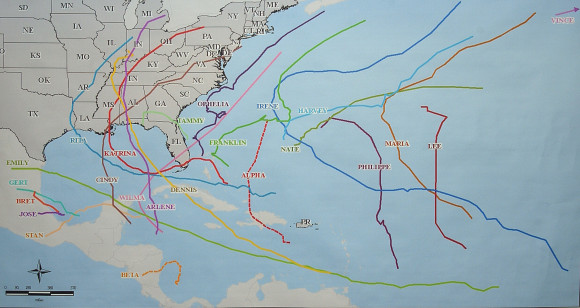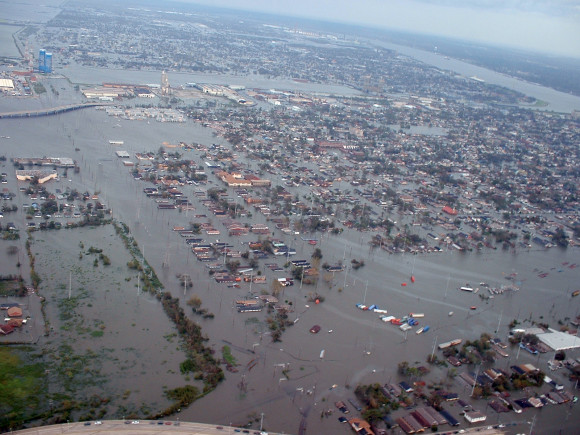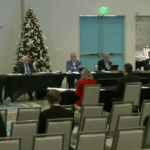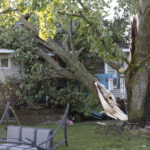Nearly 10 years ago, wind and storm surges as a result of Hurricane Katrina caused $41 billion in insured losses and $108 billion in total economic losses. Many of the lawsuits filed as a result of the fifth hurricane of 2005 have only recently been decided.
During a recent webcast, Lessons Learned From Hurricane Katrina: Looking Back, Planning Ahead, several Marsh experts weighed in on how risk management has evolved as a result of Hurricane Katrina.
James Labode, Marsh’s New Orleans Office head, recalled the storm had a major impact on communication.
“The ability to communicate was so constrained,” Labode said.
He noted that the common goal of recovery and rebuilding stood out to him.
One Business’ Personal Account
Steve Pettus, managing partner of Dickie Brennen & Co., which runs four high-end restaurants in New Orleans’ French Quarter, said the scale of the storm was unbelievable.
“We never evacuate. But this time we did,” said Pettus. Recounting his personal story, he said he left the day after Katrina hit New Orleans, on Sunday.
“It took about seven hours to drive 70 miles,” said Pettus.
He explained that the normal practice during these types of evacuations was to pack just a few things since most evacuations only lasted a few days. However, this was not what happened after Katrina. Pettus stayed with his business partner’s family for a night and then was taken in by a family he had never met before.
Due to the mandatory evacuation in New Orleans, a pass was needed to get back into the city. Pettus acquired one about six days after the storm but that was not the only hurdle to overcome.
“The challenge was that all of the resources were being consumed,” Pettus said of trying to get the restaurants back up and running.
Pettus made sure the payroll system was up and running, allowing the employees to be paid during the five week period the restaurants remained closed. The restaurant group also paid its purveyors off which, in turn, led to an incredible loyalty among its vendors that Pettus said remains today.
10 Commercial Property Policy Tripwires
At the onset, Hurricane Katrina didn’t initially appear significant, according to Duncan Ellis, Marsh’s US Property Practice leader. Once the levies broke, that changed.
While most don’t read an insurance policy until after a loss, Ellis said it’s imperative to know what’s covered ahead of time. As an example, he said many businesses were surprised to find out they were not covered for storm surge losses, the main coverage issue resulting from the storm.
Ellis and Paul McVey, Marsh’s U.S. Property Claims Practice leader, developed a list of the top 10 tripwires in a property policy arising as a result of a major loss.
Business interruption – The main questions related to whether business interruption was covered and how it was calculated. “Probably the most misunderstood coverage,” said Ellis. He added that it’s important to note that business interruption coverage does not replace revenues, but rather it replaces profits that are lost. According to McVey, another area of confusion is related to the indemnity period, which is intended for the time frame to reinstate and repair a property to its pre-loss condition.
Sublimits – McVey said this usually applies to flood coverage and includes such things as pure extra expense, expediting expense and time sublimits for civil authority.

Deductible applications – Ellis said the most common questions had to do with whether a deductible applied by occurrence or location. Separate deductibles can also apply to time element loss, by unit of insurance and even by percentages.
Service interruption – McVey said businesses should understand the scope of the coverage and understand causation and indemnity period. A service interruption must be caused by peril that is insured against. There can be distance limitations, qualifying or waiting periods which may apply to each location. He emphasized there is no coverage for cutting off service voluntarily.
Contingent business interruption – Ellis said businesses need to understand which suppliers or customers – direct or indirect – are covered. McVey recommended reviewing what constitutes a direct supplier and the contractual relationship that exists. Perils purchased for a business’ locations will apply to suppliers but if a peril isn’t insured against, suppliers won’t have coverage.
Wide area impact or idle period – Allianz Global Corporate & Specialty outlined the top three causes of global property losses during 2009-2013 as fire, earthquake and machinery breakdown. These remain the main causes of wide area impact and idle periods.
Civil authority, ingress/egress – It’s important to know how this can trigger coverage, Ellis said, noting that there is typically a limitation around the number of days covered.
Named windstorm or flood – Determine if it includes or excludes storm surge, McVey said.
Flood definition of special high hazard flood zone – Ellis explained that a special hazard flood area (SHFA) and a 100-year flood zone/plain are the same things. He pointed out that there will likely be an internal sublimit for flood with a further sublimit for SHFA.
Loss management planning and communication protocol – Pre- and post-loss management planning as well as a communication protocol is critical, said McVey. Businesses should consider such things as alternate vendors, partial payments, public relations, etc.
Disaster Plan Best Practice Tips
Some key rebuilding concerns following a disaster, according to Pettus, include:
- Staff – personal issues, housing, communications, meetings, ads, phone trees;
- Physical properties – assess disasters and construction needs;
- Customers and suppliers – order equipment; and
- Contractors.
Pettus explained what he does now to prepare for disasters:
- Build healthy cash reserves.
- Direct pay for staff.
- Carry smaller inventories, even more if a storm is forecast.
- Review insurance coverages.
- Review emergency preparedness manual each year, and identify and secure extra housing for employees.
- Have generators and redundant systems on hand, and have VOIP office phones and offsite computer services.
- Secure access passes each year from the mayor’s office.
Topics Catastrophe Natural Disasters Profit Loss Flood Hurricane Property
Was this article valuable?
Here are more articles you may enjoy.



 After Years of Pushing Rate Hikes, Florida’s Citizens Now Wants HO Rate Decrease
After Years of Pushing Rate Hikes, Florida’s Citizens Now Wants HO Rate Decrease  One of Highest Property Claims Severity Recorded in Q3 on Low Volume, Says Verisk
One of Highest Property Claims Severity Recorded in Q3 on Low Volume, Says Verisk  Suit Against OpenAI and Microsoft Blames ChatGPT for Murder-Suicide
Suit Against OpenAI and Microsoft Blames ChatGPT for Murder-Suicide  North Carolina Sting Operation Alleges Roofer Damaged Shingles to File Claim
North Carolina Sting Operation Alleges Roofer Damaged Shingles to File Claim 


